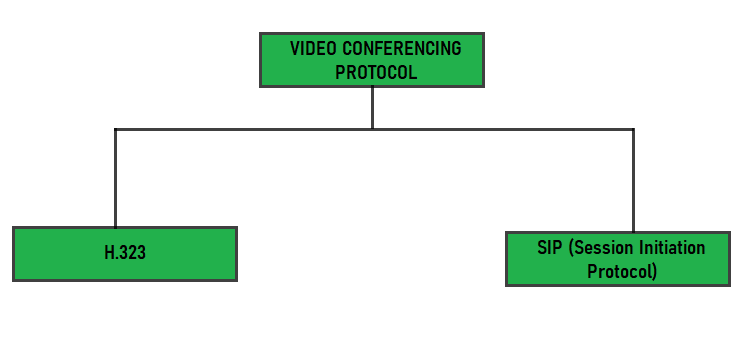Video Conferencing Protocols
Last Updated :
19 Feb, 2023
Internet communication simply means communication between two or many users over the Internet or the WWW (World Wide Web). The communication can be in the form of texting, sharing information, videos, audios, ideas, video chatting, etc. Video conferencing : Videophone/Video chatting/Video conferencing is a type of Internet Communication. Video means visual and conferencing means communication. So, video conferencing is generally a visual communication between two or many users over the Internet across the globe. Video conferencing means seeing each other while talking or face to face communication on the internet. If you have access to the internet & have smartphones or PC with a camera or laptop or tablet, then by just making a call, you can see each other while talking. Some protocols of video conferencing are listed below:  1. Video Conferencing Protocol H.323 :
1. Video Conferencing Protocol H.323 :
- Designed by ITU (International Telecommunication Union).
- Computer Language used is Binary.
- Provides multimedia communications over a variety of networks.
- It is quite complex, possibilities of delay.
- Multipoint control unit (MCU), gateway, gatekeeper (optional) and the terminal are some functioning components.
2. SIP (Session Initiation Protocol) :
- Designed by IETF (Internet Engineering Task Force.
- Computer Language used is ASCII.
- Highly Flexible and simple.
- User-Agent and Network server are two major functioning components.
- Used to establish, modify and terminate multimedia sessions or calls.
- Resembles HTTP protocol.
- Works with both IPv4 and IPv6.
Advantages
- Real-time Communication: Chat conferencing protocols allow for real-time communication between participants, allowing for immediate discussion and collaboration.
- Accessibility: Chat conferencing protocols can be accessed from anywhere with an internet connection, making it convenient for remote teams to communicate.
- Cost-effective: Chat conferencing protocols are often free or low-cost, making them a cost-effective option for businesses and organizations.
- Document Sharing: Many chat conferencing protocols allow for the sharing of documents, images, and other files, making it easy for teams to collaborate on projects.
- Increased Productivity: By enabling real-time communication and collaboration, chat conferencing protocols can help increase productivity by reducing the time it takes to complete tasks.
Applications
- Remote Work: Chat conferencing protocols are commonly used by remote workers to communicate and collaborate with team members.
- Business Meetings: Chat conferencing protocols can be used to hold virtual meetings, reducing the need for travel and saving time and money.
- Education: Chat conferencing protocols are used in education to facilitate online classes and discussions.
- Customer Support: Chat conferencing protocols can be used for customer support, allowing for real-time assistance to customers.
- Healthcare: Chat conferencing protocols are used in healthcare for telemedicine, allowing patients to communicate with their doctors from the comfort of their own homes.
Like Article
Suggest improvement
Share your thoughts in the comments
Please Login to comment...